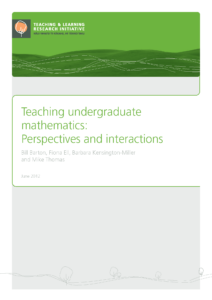The high demand for mathematics in undergraduate education means that large numbers of students enrol in the subject. Lecturing remains the prime delivery mode for teaching such courses. We addressed undergraduate mathematics’ lecturing through three components: lecturers and their development; student perspectives on mathematics; and interactions in the lecturing environment. We used theoretical frameworks from secondary contexts, developing them for tertiary application. This research aimed to improve the didactics of lecturing, and builds on studies on school/university transitions.
Key findings
- Lecturer professional development based on Schoenfeld’s framework positively influenced lecturing practice in a way acceptable to lecturers.
- Students believe that learning mathematics involves natural ability; and that it is a subject for which you need a passion.
- Undergraduate mathematics involves a larger than realised diversity of reasons for study and of approaches to learning.
- Social norms mitigating against student mathematical engagement in lectures can be alleviated using group supported lecturer development of questioning.
Major implications
- University mathematics departments can successfully undertake effective lecturing development in a way acceptable to staff, using a video/discussion group format.
- Lecturers need to beware of stereotyping students, especially avoiding “natural ability” classifications that put off students who regard themselves as “workers”.
- Undergraduate mathematics does not yet accommodate the diversity of its student body in its offerings or learning mode opportunities.
- Small-group discussion can be effective in lectures, in particular when well-developed, open questions are used non-evaluatively, avoiding perceptions of public judgement.
The research
Our project was based on our perception of undergraduate mathematics learning in New Zealand that has been only slowly influenced by educational research and, we fear, is not keeping up with contemporary student expectations. We investigated three components of undergraduate mathematics’ lecturing: lecturers and their development; student perspectives on mathematics; and interactions in the lecturing environment.
The respective aims of the project were to:
- work with mathematics lecturers to create successful professional development processes
- establish descriptions of student orientations, behaviours, and expectations of mathematics learning, particularly in lectures
- explore the use of questions to enhance mathematical thinking within a lecturing environment.
The research questions (two for each component) were:
- How can Schoenfeld’s resources, orientation and goals (rog) framework be adapted to support lecturer professional development?
- Can an effective lecturing professional development strategy be built around peer discussion of lecturer ROGs matched against videoed lecturing practice?
- What are the discourses by which students make sense of mathematics and those who study it?
- How does students’ mathematical identity at tertiary level affect their learning experiences?
- What is an effective framework of lecturer questioning that will engage students in mathematical thinking?
- How do socio-mathematical norms shape the use of questions to promote mathematical engagement in lectures?
Lecturer component
Eight members of the department of Mathematics at The University of Auckland assessed a video/discussion style of lecturer development based on the resources, orientations and goals (ROG) theory (Schoenfeld, 2010). Four were research mathematicians and four were research mathematics educators. all eight taught mathematics content.
Six members agreed to videotape at least two lectures per year, and, before and after the lectures, to write notes based on their rog for the lecture. Where possible, the same lecturer was videotaped again at a later date. at each videoed lecture another person observed and took notes. The lecturer selected a 2–4-minute excerpt from the videotape to be watched by the group. The group had three hour-long meetings each semester to discuss lecturing, prompted by viewing one or two excerpts and the ROGs. In total, 19 lectures were captured on video, and 15 full meetings were held.
Data included voice recordings of meetings, analysed against a code representing features identified as recurring or of interest. Also, each of the mathematicians was interviewed about their experience. Finally, pairs of lectures by the same lecturer made near the beginning and end of the project were given to three overseas researchers who had not been involved in the project, plus one student on a summer scholarship. For each of the three pairs, the independent evaluators were asked to identify which lecture preceded the other using their experience of lecturing, and to write reasons for their decisions.
Nearly all the discussions quickly diverged from the video to issues identified by all as familiar and interesting. occasionally, the video was used again late in the session. The ROG statements did guide some discussions, but were more a reference and context than the subject of discussion. all group members (including those not videoed) could point to specific lecturing improvements they had made.
Discussion included both pedagogical and mathematical matters in about equal proportions. The rigour and correctness of the mathematics intervened in pedagogical decisions in a way the researchers had not experienced in secondary school environments.
All lecturers welcomed, and were stimulated by, the professional development process. no-one felt that the process of videoing interfered with their lecturing or the student responses, nor that the video misrepresented their practice. despite initial reservations, no-one reported significant discomfort from being videoed or it being watched by others.
Feedback was received on possible modifications in timing, group size and composition, and frequency. all lecturers in the group have joined a voluntary follow-up programme where the research group has broken into three new groups, drawing in more lecturers from the department.
The result of the blind assessment of the three pairs of lectures was 70 percent correct, with evaluators correctly assessing which lecture was post-development in three out of four cases for lecturer a, three out of three cases for lecturer B, and one out of three cases for lecturer c. indicative characteristics reported by the assessors included confidence, student interaction, motivating examples, and content approaches.
Student component
Using Boaler’s (2002) work on identity, we gathered information about tertiary students’ experiences of learning mathematics. in the first part, more than 100 students in pure mathematics, applied mathematics and English classes at 300-level completed a questionnaire on their feelings about mathematics. The different groups of students gave a range of perspectives on learning mathematics. Thirty volunteers from this group were interviewed using an in-depth narrative technique, further exploring the students’ experiences of learning mathematics.
The second part of the study looked at the relationship between the students and their learning in a 300-level pure mathematics class that was taught using team-based learning (Michaelsen, Sweet, & Parmelee, 2008). Ten students were interviewed in the first and last week of the course, and six students were videoed on the four occasions in which they worked in groups to solve problems.
The data from the first part of the study were analysed to reveal the students’ identities as learners of mathematics, and to understand their account of how these identities were constructed. This was used to frame data collection and analysis in the second part, where the students were interviewed before and after a new type of mathematical learning experience.
The participants in both parts came from diverse backgrounds. Furthermore, they studied mathematics for a wide range of reasons. initially, we thought there would be identifiable “types” of mathematics student with similar ways of talking about learning mathematics. In fact, the students were idiosyncratic and resisted stereotypes.
There were, however, commonalities in their discourse. Two key themes emerged: that learning mathematics involves natural ability, and that you need a passion for mathematics. The students often described their work in terms of the amount of ability they had. Some students were considered geniuses who did not have to learn anything because they could just do it. Furthermore, students did not study mathematics for its utility; they studied it for love of the subject.
In the second phase of the study the collaborative learning model differed from the usual presentation of mathematics. We wondered how students would react.
Students largely welcomed team-based learning, they were more open to group work than expected, and reported enjoying the emphasis on understanding that resulted from group work. The students’ curiosity about others’ methods and ideas was evident. Those who most strongly identified as mathematicians were most open to the team-based learning format.
For the students who relied more on rote learning, the team-based approach was more challenging. The collaborative model interfered with their usual technique. rote learning was felt to be the pain you had to go through unless you were good at mathematics, when learning was not necessary. good students just “played around with it for a while and re-read it a bit”. These students identified themselves as mathematicians, whereas the rote-learning students tended to say they would not become mathematicians.
Lecturing interactions component
Students have been observed to be passive in large-scale lectures, watching the lecturer demonstrate mathematical procedures. They rarely engage in authentic mathematical activity. our goal was to improve student engagement in large lectures.
A research team of mathematicians and educators working together, using the theory of social and socio-mathematical norms of Yackel and Cobb (1996), designed a framework for conceptual questioning for a large undergraduate course. The lecturer, who was part of the team, introduced one mathematical question in each lecture for the students to briefly work on interactively in informal groups.
The team carried out observations, focusing on the effectiveness of questions; the identification and analysis of “key moments” in the lectures; and comparisons between lectures. Two cycles of questioning, observation, reflection, and re-implementation were completed. The lecturer kept a journal, and the research group met to discuss the intervention. discussions were recorded.
Students were surveyed at the beginning and end of the course on their lecture expectations, beliefs and attitudes. Two focus groups were interviewed. The student and lecturer findings were then cross-referenced.
The cycle of developing, testing, reflecting and then refining, did result in questions that engaged students mathematically in lectures.
The lecturer had previously used a teacher-centred style of teaching, believing in the effectiveness of such pedagogy. The research revealed that the lecturer’s espoused and enacted beliefs regarding lecturing were not always compatible, but through this process some of these beliefs changed.
The practice of collaborating with a group of mathematics educators, who were analytical but encouraging, was a safe environment for the lecturer to reflect and challenge his beliefs. The research led us to believe that a minimum of three mathematics lecturers, some with mathematics education experience, is necessary for productive academic discussion. Having a practical goal on which to focus initially—for example, how to make lectures less passive—was an important driver for developing trust within the group. Meeting regularly was another key factor for building trust. We found that making changes or modifying beliefs can take many cycles of testing and reflecting.
The successful questioning technique, known as Stop–Think–Discuss, began with relatively easy procedural questions that students could answer to establish small-group social norms. once students were comfortable interacting more conceptual questions were introduced. The optimal time for the questions was in the middle of the lecture. open questions were the most successful as they were accessible for all without the fear of being wrong.
Our study revealed that lecturers have a strong part to play in establishing new social norms, with students willing to break old norms if the lecturer explicitly instructs them to do so. although students may prefer to participate in social norms of passive student behaviour in transmission-style lectures, we showed that it is possible to renegotiate the didactical contracts that exist between lecturers and students and establish new norms. Furthermore, the lecture goals needed to be adjusted from “covering the content” to “developing mathematical understanding”. This case study succeeded in creating student interactions that contained mathematical engagement.
Major implications
Lecturer component
The video/discussion process was positively received by lecturers. All participants not only felt it was the best professional development they had had, but all wanted to continue. Most value was gained from the group meetings and discussions, although writing the ROGs and watching themselves were also positively regarded.
Both pedagogical and mathematical issues were the subject of discussion and were reflected in improved lecturing. Thus the professional development strategy is not only a source of improvement in both areas, but is also a site where the integration of pedagogy and content takes place effectively.
There is objective evidence that this professional development process is effective in terms of improved lecturing performance, even in the time span of the project. The outsider evaluation of videoed lectures correctly identified the pre- and post-lectures of the pairs in 7 of the 10 case studies, with explicit reasons given.
We conclude that there is good evidence that this form of professional development is viable, effective, and positively received. Hence we strongly recommend a version of this programme be considered in mathematics and statistics departments in universities nationwide.
Student component
The identities of adult learners shape their approach to learning and therefore pose a challenge for those who teach them.
Students were shown to be more idiosyncratic than expected, thus lecturers need to avoid stereotyping students along any dimensions.
The “natural ability” and “passion” discourses have implications for participation in higher-level mathematics: can you study mathematics if you are not naturally gifted and you do not really love it? Mathematics departments need to address these blockages to wider participation in higher education in the mathematical sciences if they are to reach out to non-majoring students.
Students, particularly those who identify themselves as mathematicians, were open to group and collaborative learning, including at advanced undergraduate levels. Rote learning was regarded as problematic “but necessary” under traditional teaching modes unless one had natural ability. Mathematics departments will need to make it clear that any student can potentially do well mathematically, and major in the subject, if they are prepared to work; and also that “natural ability” is not sufficient on its own.
The study highlights the diversity of learning approaches among students that lecturers face, even at 300-level. Furthermore, the students’ learning histories influence how they interact with new mathematics.
Lecturers are likely to be more effective if they invest some time understanding how students regard mathematics, why they are taking the subject, and how they tackle new learning.
Lecturing interactions component
The case study showed that it is possible to change lecturer beliefs and student socio-mathematical norms about learning in large-class lecture situations so that students spend some time working in small informal groups engaged in mathematical activity. In this study, the change in lecturer beliefs took time, and was a gradual, iterative process. The change occurred in an environment of supportive colleagues who met regularly over an extended period to reflect on the different types of questions the lecturer introduced and how effective these were with the students.
There is every reason to believe that this case study could be reproduced with any lecturer/large class provided that there is a supportive group for the lecturer to work with, and the lecturer is a willing participant.
One implication of the study is that even if large-class lecturing is necessary for administrative reasons or economies of scale, this does not mean that students are doomed to passive learning for most of their contact time. The lecturer has the power to set the socio-mathematical norms in the lecture and involve students in active learning. In this way, student and lecturer beliefs about lecturing can be adjusted, so that students will engage in mathematical activity for part of the time.
References
Boaler, J. (2002). The development of disciplinary relationships: Knowledge, practice and identity in mathematics classrooms. For the Learning of Mathematics, 22(1), 42–47.
Michaelsen, L. K., Sweet, M., & Parmelee, D. X. (Eds.) (2008). Team-based learning: Small group learning’s next big step. San Francisco, CA: Jossey-Bass.
Schoenfeld, A. H. (2010). How we think. A theory of goal-oriented decision making and its educational applications. New York: Routledge.
Yackel, E., & Cobb, P. (1996). Sociomathematical norms, argumentation, and autonomy in mathematics. Journal for Research in Mathematics Education, 27(4), 458–477.
Project team
Principal investigators
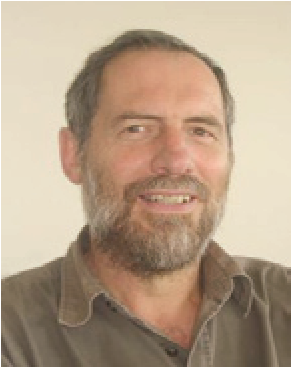 Bill Barton is a professor in the Mathematics Department at The University of Auckland, teaching undergraduate mathematics and postgraduate mathematics education. He researches mathematics and language, and undergraduate mathematics teaching. Current President of the International Commission on Mathematical Instruction, Bill directs the Klein Project, an international effort to communicate contemporary mathematics to teachers. Bill Barton is a professor in the Mathematics Department at The University of Auckland, teaching undergraduate mathematics and postgraduate mathematics education. He researches mathematics and language, and undergraduate mathematics teaching. Current President of the International Commission on Mathematical Instruction, Bill directs the Klein Project, an international effort to communicate contemporary mathematics to teachers. |
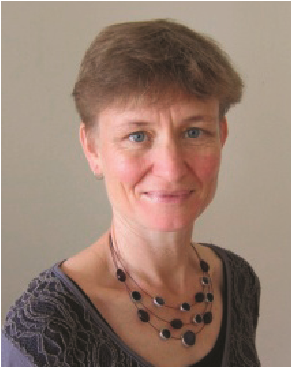 Dr Fiona Ell is a lecturer in the Faculty of Education at The University of Auckland. She teaches mathematics education and professional practice to pre-service primary teachers. Her research work centres on how people learn in complex social contexts, from primary classrooms to tertiary settings, using primarily qualitative methods of inquiry. Dr Fiona Ell is a lecturer in the Faculty of Education at The University of Auckland. She teaches mathematics education and professional practice to pre-service primary teachers. Her research work centres on how people learn in complex social contexts, from primary classrooms to tertiary settings, using primarily qualitative methods of inquiry. |
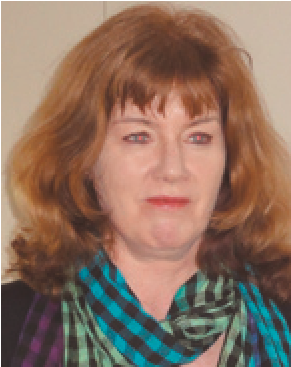 Barbara Kensington-Miller is a lecturer in the centre for academic development at the University of Auckland. She advises academic staff on aspects of their teaching and research, and in particular works with early-career academics. Her background is in mathematics education and much of her research in higher education extends into this discipline. Barbara Kensington-Miller is a lecturer in the centre for academic development at the University of Auckland. She advises academic staff on aspects of their teaching and research, and in particular works with early-career academics. Her background is in mathematics education and much of her research in higher education extends into this discipline. |
Mike Thom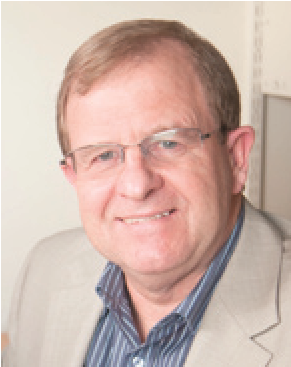 as is a professor in the Mathematics Department at The University of Auckland. His research interests in mathematics education include undergraduate mathematics, technology use, advanced mathematical thinking (including theoretical constructs), algebra and calculus learning, teacher and lecturer practice, and links with cognitive neuroscience. He has written more than 150 refereed papers. as is a professor in the Mathematics Department at The University of Auckland. His research interests in mathematics education include undergraduate mathematics, technology use, advanced mathematical thinking (including theoretical constructs), algebra and calculus learning, teacher and lecturer practice, and links with cognitive neuroscience. He has written more than 150 refereed papers. |
| Other members of the research team: Hannah Bartholomew, Sheffield Hallum University, UK; and Lisa Darragh, Steven Galbraith, Mike Meylan, Judy Paterson, Claire Postlethwaite, Greg Oates, Louise Sheryn, Jamie Sneddon, Sepideh Stewart, Steve Taylor and Caroline Yoon, all of The University of Auckland. |
Research Partners
The lecture interactions and lecturer components are working with groups of mathematicians within the University of Auckland. The team involved in the lecturer perspectives component includes Dr Steven Galbraith, Dr Mike Meylan, Dr Clare Postlethwaite and Dr Steve Taylor. In the lecture interactions component, the partners are the team involved in teaching maths 108, a large, multi-stream lecture course. The individuals involved varies from semester to semester, but always includes mathematicians who are not otherwise engaged in research in mathematics education. The student perspective includes in its research team two former masters students who are teachers in Auckland schools: Lisa Darragh from Kowhai Intermediate, and Jeanette Saunders from St Cuthbert’s College.

